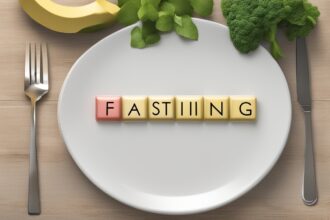Intermittent fasting (IF) has gained immense popularity as a weight loss strategy, and for good reason. It’s not just a diet but a lifestyle change that focuses on when you eat rather than what you eat. If you’re looking to shed pounds and improve your overall health, intermittent fasting slimming tips can be a game-changer. This post will guide you through practical and effective ways to make the most of intermittent fasting for weight loss, ensuring you achieve sustainable results.
What Is Intermittent Fasting and How Does It Help with Slimming?
Intermittent fasting is an eating pattern that cycles between periods of eating and fasting. Unlike traditional diets that restrict specific foods, IF focuses on timing. Common methods include the 16/8 method (fast for 16 hours, eat during an 8-hour window), the 5:2 diet (eat normally for 5 days, restrict calories on 2 days), and alternate-day fasting. The primary way IF aids in slimming is by reducing overall calorie intake and improving metabolic health. During fasting periods, your body taps into fat stores for energy, promoting weight loss. Additionally, fasting can lower insulin levels, making it easier for your body to burn fat.
If you’re new to this approach, start with a simple schedule and gradually adjust. For more insights on how fasting impacts metabolism, check out our detailed guide on how fasting boosts metabolism.
Top Intermittent Fasting Slimming Tips for Beginners
Starting intermittent fasting can feel daunting, but with the right strategies, it becomes manageable and effective. Here are some beginner-friendly intermittent fasting slimming tips:
- Start Slow: Begin with a 12/12 schedule (12 hours fasting, 12 hours eating) before progressing to more intense methods like 16/8.
- Stay Hydrated: Drink plenty of water during fasting periods to curb hunger and support detoxification.
- Plan Your Meals: Prepare nutrient-dense meals for your eating window to avoid overeating or choosing unhealthy options.
- Listen to Your Body: If you feel dizzy or overly fatigued, adjust your fasting schedule or consult a healthcare professional.
By easing into IF with these tips, you’ll build a sustainable routine. Curious about meal planning? Explore our post on healthy meal prep ideas for weight loss.
Optimizing Your Eating Window for Maximum Weight Loss
One of the key aspects of intermittent fasting slimming tips is mastering your eating window. The goal is to consume enough calories to fuel your body without overindulging. Focus on high-protein, high-fiber foods that keep you full longer, such as lean meats, vegetables, and whole grains. Avoid sugary snacks and processed foods, as they can spike insulin levels and hinder fat-burning. Additionally, try to eat your largest meal earlier in your window, as studies suggest that eating earlier in the day aligns better with your body’s natural circadian rhythm, enhancing metabolism.
Timing matters, so experiment with different eating windows to see what works best for you. For more on balancing macros during IF, read our article on balancing macros for fat loss.
Combining Intermittent Fasting with Exercise for Better Results
Pairing intermittent fasting with exercise can supercharge your slimming efforts. Working out during a fasted state, such as a morning jog before breaking your fast, may enhance fat-burning as your body relies on stored fat for energy. However, keep workouts moderate during fasting periods to avoid burnout. Strength training and low-intensity cardio are excellent choices. Post-workout meals within your eating window should prioritize protein to aid muscle recovery and prevent muscle loss.
Always ensure you’re not overexerting yourself. If you’re looking for workout ideas, check out our guide on low-impact exercises for weight loss.
Managing Hunger and Cravings During Fasting Periods
Hunger and cravings are common challenges when starting intermittent fasting, but they can be managed with the right intermittent fasting slimming tips. First, stay hydrated—sometimes thirst is mistaken for hunger. Drinking black coffee or herbal tea (without sugar or cream) can also suppress appetite. If cravings hit, distract yourself with light activities like walking or meditation. Over time, your body will adapt to fasting, and hunger pangs will diminish. Keeping busy and maintaining a consistent fasting schedule can also help train your mind to resist unnecessary snacking.
For additional strategies on curbing cravings, see our post on managing food cravings effectively.
Common Mistakes to Avoid with Intermittent Fasting for Slimming
While intermittent fasting is effective, certain pitfalls can derail your progress. One common mistake is overeating during eating windows, which negates the calorie deficit needed for weight loss. Another is neglecting nutrition—fasting doesn’t mean you can eat junk food without consequences. Additionally, some people push themselves too hard too soon, leading to fatigue or irritability. Avoid skipping essential nutrients and ensure you’re getting enough sleep, as poor rest can disrupt hunger hormones like ghrelin and leptin.
By sidestepping these errors, you’ll maximize the benefits of IF. Remember, consistency and balance are key to long-term success.
Disclaimer: The information provided in this post is for educational purposes only and should not be considered medical advice. Intermittent fasting may not be suitable for everyone, especially individuals with certain medical conditions, pregnant or breastfeeding women, or those with a history of eating disorders. Always consult with a healthcare professional or registered dietitian before starting any new diet or fasting regimen to ensure it is safe and appropriate for your individual needs.
References
- Harvard Health: Intermittent Fasting – Surprising Update
- Mayo Clinic: Intermittent Fasting FAQ
- NCBI: Effects of Intermittent Fasting on Health, Aging, and Disease
- WebMD: Intermittent Fasting Overview
- Johns Hopkins Medicine: Intermittent Fasting – What Is It and How Does It Work?
This content is for informational purposes only and not a substitute for professional advice.






